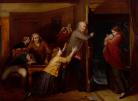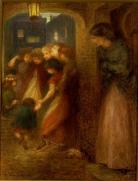Porphyria's Lover and the Objectification of Women in the 19th Century
Created by Kentavia Humphrey on Fri, 12/03/2021 - 11:45
Part of Group:
Women during the 19th century were objectified and classified as "Fallen Women" and/or "Angel in the House". During this time, there were a lot of male painters or photographers that presumed on this subject itself. In this timeline, I will portray images of such fallen women during the 19th century and give broad details and gruesome stories on many antics during the time.
Timeline
Chronological table
| Date | Event | Created by | Associated Places | |
|---|---|---|---|---|
| 1851 |
The OutcastThis painting was created by Richard Redgrave and represents a fallen woman with her illegitimate child being evicted from her home by her stern father, despite the pleadings of the family. On the floor is a purse of money and an incriminating letter. The scene is made more pathetic by the snowy wastes outside the door and the innocent child’s hand raised in the echo of the hand of the pleading sister. This painting shows the objectification of the "fallen woman" as even though the painting there are things the simplify maybe Redgrave did not sustain that the norms of women during the 19th century were justifiable. In his painting, there are so many red and dark colors but somehow there is a splash of yellow which may seem to portray the imagery of hope. I chose the painting to show the discredit of the woman during the 19th century and how even though she seemed to portray her life as she pleased that she will always be seen as an outcast. In Browning's "Porphyria's Lover", we see how the narrator portrays Porphyria as an outcast as he describes her day as he uses words such as "gayfest". |
Kentavia Humphrey | ||
| 1857 |
The Great Social EvilThis painting by John Leech portrays the imagery of Bella being called gay due to her being a prostitute. During the 19th century, the term gay was not used to specify sexuality, but to show the imagery on prostitution and during the era of the "fallen woman". I chose this image to depict that in fact reading Browning's Porphyria's Lover that she was not inducing a gayfest of homosexuality but Porphyria was into prostitution. |
Kentavia Humphrey | ||
| 1864 |
The Gate of MemoryThis painting was depicted by Dante Gabriel Rosetti in the painting we see a young woman standing besides a building in an alleyway watching others parade around. However the painting can be translated to those of a prositiute standing at an archway watching those parade around of innocence and morals and recognizes helself as once a person with the same innocence as those who are dancing. I choose this painting to depict the innocence of Prophyria during the poem writing by Browning. Even though Prophyria was suggested to be a prositute in the poem, I believe the narrator knew Prophyria should disperse from the negative entity of prositution. As I think he believed he releived Prophyria of the sins and choose to resuscitate her innocence. |
Kentavia Humphrey | ||
| 1867 |
Found DrownThis painting is by George Frederic Watts RA of a woman beneath the shores of the Waterloo Bridge in London. During the Victorian Era, there were women who portrayed the narrative of desire, illegitimacy, and religion. These women were known as "fallen women". Watts was inspired by the poem " The Bridge of Sighs" which describes the life of a young woman who is destroyed by love, who becomes pregnant and homeless and eventually commits suicide. This art takes on the display of the image of a "fallen woman" which shows the complexity of ethics, virtues, and pity. I chose this image because of the ethics and pity shown by the narrator in Porphyria's Lover, in the poem Porphyria is a "fallen woman". Throughout the poem, we get the understanding that Porphyria is not married to the narrator, but they are in an entanglement. |
Kentavia Humphrey | ||
| 1891 |
Map of Whitechapel Murder LocationsThis map identifies the exact locations of women who were gruesomely murdered in Whitechapel, London in the East End. There were knowingly 11 murders committed during the time of April 3, 1888, and February 13th, 1891. The murders were known as the " Whitechapel Murders". Many of the women who were murdered during the time of these killings were prostitutes or fallen women in the 19th century. The stories and details of the killings show that not only were these women murdered but they were not killed instantly, These women had been beaten, stabbed, mutilated, and strangled. It was shown how Jack the Ripper (the name given to the serial killer) never had any motives of killing these prostitutes but however one may conclude that he could have also been a moral crusade that wanted to destroy the world of immoral and unethical vice. However, the narrator in Porphyria's lover could also further their argument in the same direction. The narrator intruded that killing Porphyria was not only something that felt right but he also configures that even though he killed Porphyria God was silent. I believe the intention of Jack the Ripper and the narrator could insinuate that they both did the work of God as they killed those who lived unethically and non morally lives. |
Kentavia Humphrey |





